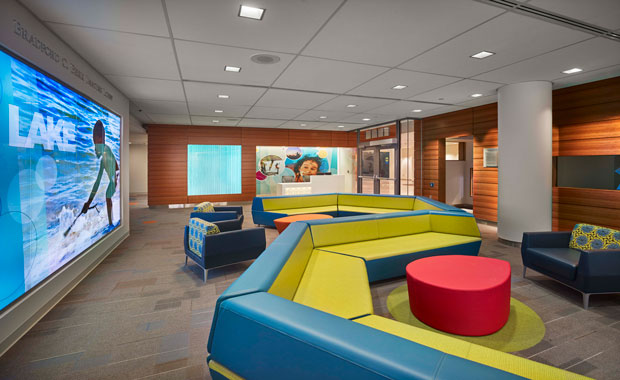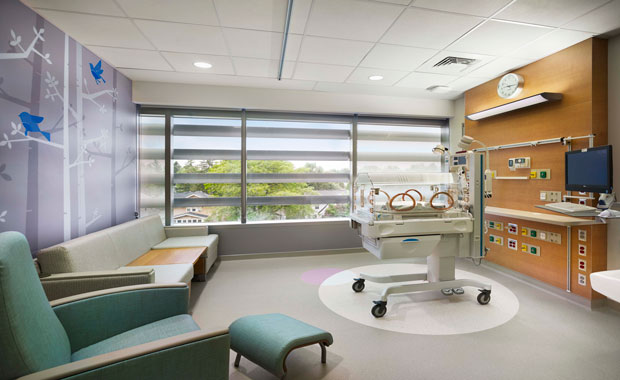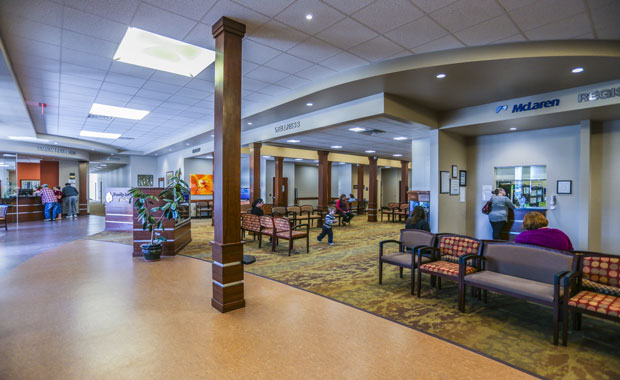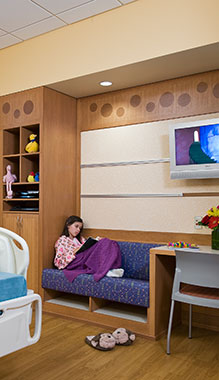A Sound Plan: How To Achieve Optimal Healthcare Acoustics
As the lowest-scoring category in the HCAHPS survey since 2007, quiet hospital environments are a challenging issue.
Other Press Ganey surveys also rank noise as a top-five complaint among hospital patients. And while the World Health Organization recommends that noise not exceed 35 dB, many studies conducted in hospitals have found average background noise ranges between 45 dB and 68 dB, peaking at more than 90 dB.
Whether it’s persistent alarms, buzzing equipment, traffic in the corridors, or staff conversations, excessive noise can negatively impact healing—and a hospital’s bottom line.
“Considerable evidence has shown that pervasive noise elevates psychological and physiological stress in patients, elevating blood pressure, heart rates, and perception of pain,” says Tina Larsen, principal at Corgan (Dallas). “Reduction of noise can go a long way in reducing stress in patients and staff, improving patient satisfaction scores, and thus has the potential to improve reimbursement.”
Targeted design
While achieving good acoustics often requires operational changes, there’s much that can be done at the design stage, too. For instance, Larsen says same-handed rooms provide distance between patient doors, which helps reduce sound transmission, even when the doors are left open.
Additionally, “same-handed rooms eliminate headwall penetrations—e.g., oxygen pipes capable of transmitting high-frequency sounds—on both sides of a patient room wall, which is good,” says Benjamin Davenny, senior consultant in acoustics at Acentech (Cambridge, Mass.). “However, they also put one patient room’s toilet wall adjacent to another patient room’s non-toilet wall, leading to potential plumbing noise transfer, unless the plumbing wall is adequately addressed.” To do so, double-stud construction can be used to prevent pipes from coming into rigid contact with the wall framing supporting the gypsum wall board on the adjacent patient room. Alternatively, Davenny recommends resilient pipe clamps to attach the plumbing pipes to the stud framing and prevent the pipes from touching the wall.
Larsen notes that mirrored rooms’ back-to-back headwalls are also vulnerable to sound transmission caused by electrical and medical gas penetrations in outlets along the shared wall and outside of headwall units. One potential fix is sound-attenuating insulation. “The most effective approach is a double-stud wall with a small air space between the walls of approximately 3/4 inch to 1 inch, completely isolating one side from the other,” she says.
To better control noise entering patient rooms, Davenny says an inboard configuration with toilet rooms placed adjacent to the corridor creates a nice barrier between the patient bed and door. However, another consideration is that inboard toilets may obstruct staff’s ability to observe patients from outside. Consequently, this isn’t an ideal layout for higher acuity rooms such as cardiac care or for patients with fall risks. However, in spaces like postpartum units, the inboard configuration would be an effective choice.
Nurses’ stations are also often sources of noise. Rich Dallam, partner at NBBJ (Seattle), says, “We recommend hospitals incorporate dispersed nursing zones, which not only keeps staff closer to their patients but also prevents employees from congregating in one place.” While the approach will likely limit hallway conversations, it’s important to provide staff with spaces where they’re able to meet and collaborate, and that are acoustically separated from patient areas, such as closed offstage rooms and staff lounges.
Sound-absorbing surfaces
The selection of fabric, flooring, and ceiling materials can also have a significant effect on sound reduction in healthcare facilities.
For example, Anna Mancini, an interior designer at Shepley Bulfinch (Boston), recommends acoustic ceiling tiles with a high noise reduction coefficient (NRC), rubber flooring, sound-absorbing flooring backing, and sound-absorbing wall panels to limit noise transmission levels. Tom Simbari, senior project manager at Bergmann Associates (Rochester, N.Y.), adds acoustical lay-in ceiling tiles and perforated specialty tiles with acoustical baffles to the list. While carpeting is a good noise-softening option, it’s not appropriate for patient care areas, so architects instead suggest using sheet vinyl or sheet linoleum flooring products, which offer decent acoustics.
On a smaller scale, products such as hospital-grade fabrics for privacy curtains can be useful in minimizing noise transmission. However, in higher profile public areas, or patient areas where a greater level of finish is preferred, designers may need to splurge on more expensive acoustically rated products, such as a wood-look ceiling system with an acoustical liner.
At Milwaukee’s Children’s Hospital of Wisconsin, which opened in 2009, Shepley Bulfinch specified acoustic wall panels for the patient room footwall to soften the sound traveling between rooms. “The panels are installed at voice level and are built into the millwork to create an elegant, flush feature wall,” Mancini says. In addition, antimicrobial, washable fabric panels were wrapped around a dense acoustical substrate with picture rails between them for displaying artwork and cards.
On the Lunder Building for Boston’s Mass General Hospital, which opened its doors in 2012, NBBJ was able to reduce noise levels to 46.5 dB, which is 35 percent lower than average hospitals, through strategies including installing acoustical tiles, large sliding glass doors, and rubber flooring in the patient rooms, as well as using noise machines, Dallam says.
When selecting products, Larsen says designers should consider the NRC value that measures sound absorption properties. Low is considered below 0.60, and 0.65 to 0.85 falls in the medium range. Additionally, ceiling attenuation class (CAC) values below 25 will block mechanical system noise emanating from the plenum space and noise traveling across a partition to an adjacent space.
It’s not always possible to find products with low NRC and CAC values, so architects often need to determine which sound-reducing values are the priority for a given space. For example, glass fiber panels offer lower CAC values with high NRC values, so these products are useful in waiting areas, corridors, and other public spaces such as cafeterias where CAC ratings aren’t particularly important, Larsen says. Glass fiber panels are an option to improve the acoustic work environment for staff stationed near noise-producing equipment such as robotic pharmacy equipment, she adds. However, for patient rooms and other spaces that should be treated with greater sensitivity to mechanical noises from plenum spaces, mineral fiber panels with low NRC ratings and higher CAC ratings are appropriate.
Mitigating mechanical noise
In addition to materials solutions, mechanical noise can be addressed by first referencing mechanical equipment manufacturers’ sound values. “These values provide an indication of how sound from the equipment will be perceived by humans and are compared to typical data for acceptable sound levels for spaces where the equipment is being considered for application,” Simbari says.
Furthermore, maximum sound levels for spaces are listed in ASHRAE standards and Facility Guidelines Institute’s Guidelines for Design and Construction of Health Care Facilities. With this information, engineers are equipped to design and size the equipment, and ensure that the specified equipment doesn’t exceed maximum sound levels.
For example, Davenny says that noise created by turbulent airflow emanating from air ducts, particularly in patient spaces, can be reduced by enlarging the ducts and sizing them for lower friction rates. This approach also allows owners to capitalize on reducing both energy consumption and the required fan capacity. Additionally, “fan noise from the air handling equipment can be reduced with fan selection and duct silencers, and structure-borne noise from equipment vibration can be reduced by mounting vibrating equipment on spring isolators made with coiled metal rods or elastomer isolators made of rubber or neoprene,” he adds.
Simbari recommends ensuring that all penetrations—telephone and computer cables, electrical conduits, plumbing piping, sprinkler piping, electrical outlets and switches, and medical gas piping—are properly detailed and installed, including limiting penetrations through walls where possible by using appropriate acoustical sealants. “Other factors considered to minimize noise from mechanical equipment, as perceived in normally occupied spaces, include duct arrangement, the length of runs, and use of elbows and duct silencers or acoustical lining of fittings,” Simbari says.
While elbows (fabricated angle fittings) help absorb sound into the duct wall, acoustic duct liner on the interior of ducts can also help. In cases where sound is even more of an issue, a duct silencer—typically a larger section of duct with baffles installed midstream—can be very effective. “Applications of these measures depend on numerous factors including sound generated by equipment, function of the space being served and the acceptable sound levels for such spaces, velocity of air in the duct, allowable pressure drop to compensate for the sound attenuation device/approach, and the physical space available,” he says.
Yet another potential source of unwanted noise is back-to-back electrical or data outlets in adjacent rooms, so offsetting these devices is important, Larsen says. Furthermore, noise-producing equipment such as ice machines, vending machines, refrigerators, and freezers should be physically separated from open corridors, if possible.
Keep it down
Manufacturers are continuing to develop products that further address sound masking in healthcare settings. For example, an antimicrobial, acoustically rated wall and a HIPAA-approved voice privacy masking system are both in the works. Meanwhile, Davenny anticipates that improvements in medical device and alarm interoperability/communication will produce fewer nuisance alarms, too.
Ultimately, the rapidly changing healthcare scene—driven by uncertainties with healthcare reform in the wake of a new Republican administration, evolving HIPAA regulations, and advancing technology—will surely impact how care is delivered and how acoustics comes into play in healthcare design, Simbari says.
“Patients don’t want to hear what’s going on in the room next to them. The expectation is that the design will help provide a patient experience that encourages healing and creates a positive environment and experience,” he says.
Barbara Horwitz-Bennett is a freelance writer based in Jerusalem. She can be reached at bbennett@bezeqint.net.







